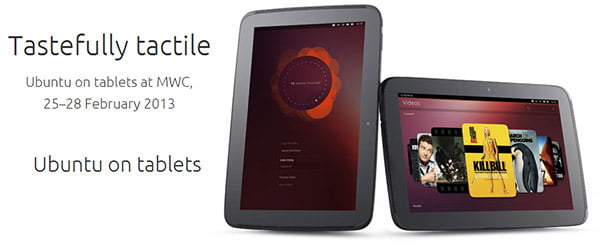After the recent launch of Ubuntu OS for smartphones, Canonical has unveiled Ubuntu for Tablets, bringing in unique multitasking productivity, effortless navigation and defence-ready security OS for tablets.

Ubuntu for tablets are fully optimized to run on ARM based chips, supporting screen sizes from 6″ to 20″ and resolutions from 100 to 450 pixels per inch. When docked with a keyboard, mouse, and monitor Ubuntu tablet can be provide a full PC experience. That way you get a all in one phone, tablet, media streamer, and PC experience with a single OS. Some of the unique feature of Ubuntu for Tablets include –
- Multitasking – Ubuntu’s unique side stage places a phone and a tablet app on the same screen at the same time for amazing tablet productivity. Users can take calls in Skype while they work in a document, make notes on the side while they surf the web, tweet while they watch a movie or drag content from one app to another to become more productive.
- Multiple secure user accounts – Ubuntu tablet has multiple secure user accounts, and a guest account. Perfect for families and friends, and ideal for the office, with secure multi-user logins that make using and sharing devices safe.
- Four edge navigation – Use all four edges of the screen to navigate between apps, settings and controls
- Voice control in the HUD – Ubuntu HUD makes complex application workflows simple on touch devices. This brings all the power of the PC to your touch device. And with voice control, it’s as if you had an extra set of hands – a truly personal assistant.
- Instant share and cloud connections – Sharing is now built-in, with support for all the major networks. Ubuntu One is deeply integrated on Ubuntu devices, it provides free storage, paid-for music streaming services and a foundation for cloud-based services from operators and device makers.
- Full convergence – Ubuntu uniquely supports a new category of convergence device – add a keyboard and mouse and your Ubuntu tablet becomes a full PC and thin client, with access to Windows apps over standard protocols from Microsoft, Citrix, VMware and Wyse.
- Content focus – Media is neatly presented on the customisable home screen, which can search hundreds of sources. Perfect for carriers and content owners that want to highlight their own content, while still providing access to a global catalogue.
Entry level Ubuntu tablet requires minimum Dual-core Cortex A15 processor with 2GB RAM, 8GB flash storage and preferred screen size of 7-10inch. High-end Ubuntu tablets can go up to Quad-core A15 or Intel x86 processor with minimum 4GB RAM, 8GB flash storage and preferred screen size of 10-12inch. Ubuntu for tablet will be made available to developers on February 21st, 2013 and first devices to get taste of it are Google’s Nexus 7 or Nexus 10. Installable images and source code will be available from developer.ubuntu.com.
So ready to explore Ubuntu on your Nexus devices. Let us know what do you think about it.
Source – Ubuntu on Tablets


